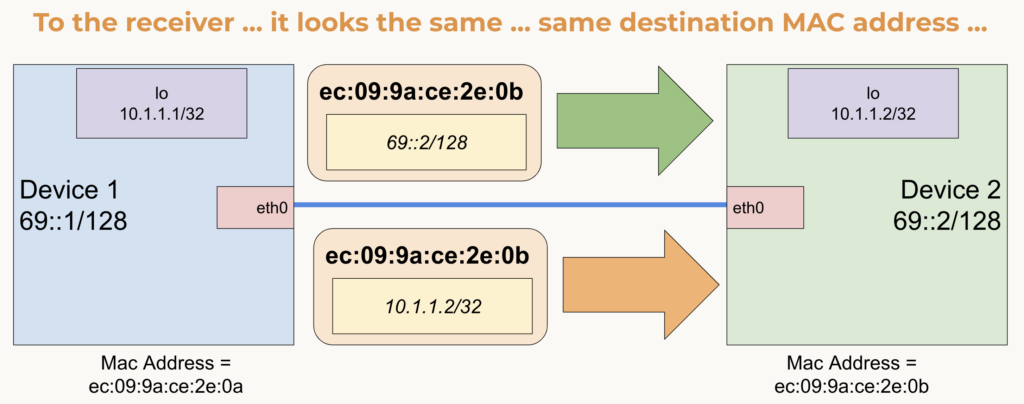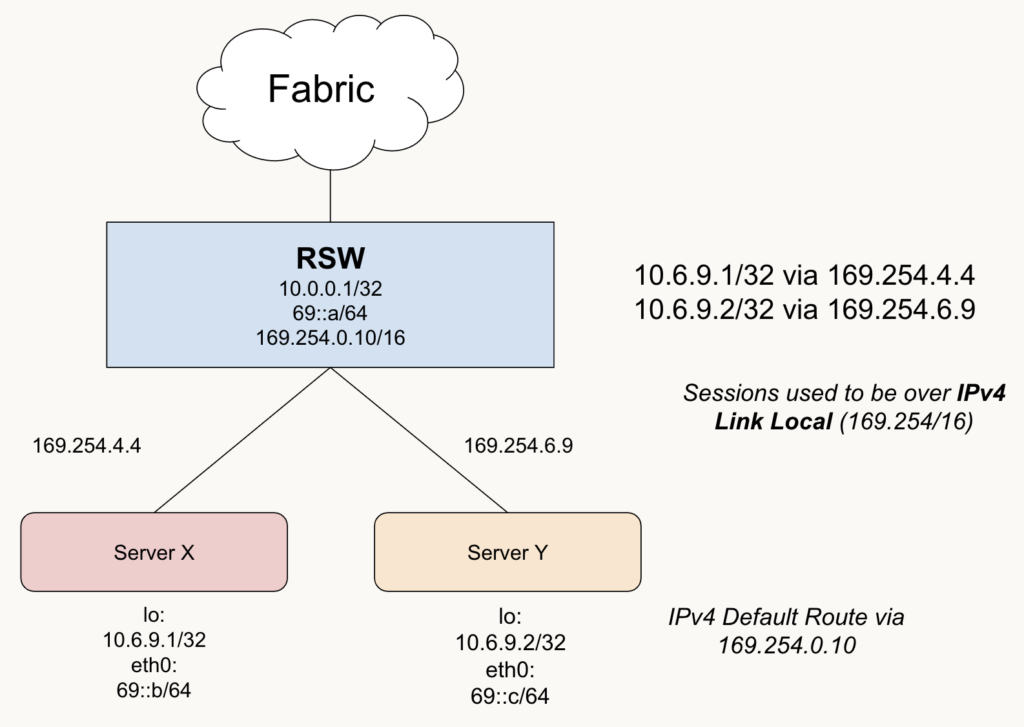IPv4 addressing on links is no longer required to route IPv4. What you say?? Yes, you can stop IPv4 addressing your point to point links with Legacy IP and route your IPv4 addressed packets via IPv6 next hops!
- With this we can save Public IPv4 addressing!
- We now only need a Public IPv4 loopback on Internet routers
- No more wasting valuable IPv4 Public Space
- with our /31s (or even /30s)
- Gotta have those network and broadcast addresses ... So my CCNA training says!
How does this work??
Routers encapsulate Layer 3 IP packets into a Layer 2 frame on an ethernet networks. Most of the world today uses ethernet. Ethernet routers pull MAC address to send the frame from two sources today:
- ARP Table for IPv4
- Neighbor Table for IPv6
Having an IPv4 prefix routed by a IPv6 next hop just tells routers to look in the neighbor table to get the MAC address and no longer use the ARP table during encapsulation. The IP packet is then untouched and encapsulated as it would be using an IPv4 next hop and looks no different to the destination device. This is a truely simplistic, great solution to allow us to continue to routing legacy IP, but not add tech debt addressing our devices with said legacy.
IPv6 Link Local
You can use the auto configured IPv6 Link Local prefixes as your next hops too. IPv6 has the fe80::/10 prefix allocated as a Link Local scoped prefix. This prefix can not be routed. Every IPv6 enabled interface auto configures (by default) a Link Local prefix using it's MAC address to generate a unique address. Due to this, a router can even not have Site or Global scope IPv6 addressing on it's interfaces. Using Link Local addresses it can still be able to route both IPv4 and IPv6. The Terragraph project addresses it's networks like this.
If you do deploy your network this way, I would recommended to have a routable loopback address so you can contact the box inband. This would not be required, but without a routable address it would render traceroutes and pings ineffective for debugging and testing connectivity. All ICMP responses wouldn't be sent by the routers.
Why keep an IPv4 Loopback?
If you'd like ICMP responses, for say traceroute, it's still recommended that you keep a loopback adddress. Most people add /32 addresses to a loopback device on their network devices and doing so here will allow the device to have a source address for the legacy ICMP headers.
Note: I realize you lose what ingress interface you hit on a router without IPv4 p2p addressing
- I feel this is a small price to pay since I know you're busy IPv6'ing everything ... right?
How do you see an ARP table?
On Linux:
cooper@l33t:~$ arp -an
? (10.251.254.1) at 02:42:0a:fb:fe:14 [ether] on br-a40df68e252d
? (173.255.255.1) at 00:00:0c:9f:f0:05 [ether] on eth0How do you see a Neighbor Table?
On Linux:
cooper@l33t:~$ ip -6 neighbor
fe80::42:aff:fefb:fe17 dev br-a40df68e252d lladdr 02:42:0a:fb:fe:17 STALE
2600:3c01::8678:acff:fe0d:a641 dev eth0 lladdr 84:78:ac:0d:a6:41 router DELAYRFCs
- RFC8950 - "Advertising IPv4 Network Layer Reachability Information (NLRI) with an IPv6 Next Hop"
- RFC5549 - "Advertising IPv4 Network Layer Reachability Information with an IPv6 Next Hop" (obsolete)
Case Study: Simple Server to Rack
Using IPv4 Next Hops
- Here we are using IPv4 Link Local in our rack as the next hops
- The ARP table would be consulted here for looking up the next hop's MAC address
- e.g. 169.254.6.9
Using IPv6 Next Hops
The same rack, but with IPv6 next hops for the IPv4 prefixes.
- Here we are using IPv6 next hops
- The Neighbor Table would be consulted to get the MAC address for the L2 Frame encapsulation
OSS Support
- ExaBGP Support v4 via IPv6: Sample Config
I am sure there are more. Comment away other suggestions and I'll add.
Vendor Support
- TODO: Finish + add config snippets
Cisco
TBA
EOS
- We have EOS doing IPv4 via IPv6 @ Meta
TBA
JunOS
TBA



Write a Reply or Comment